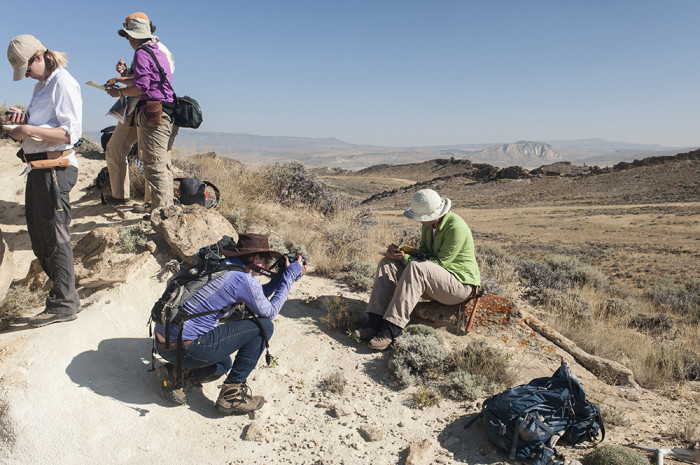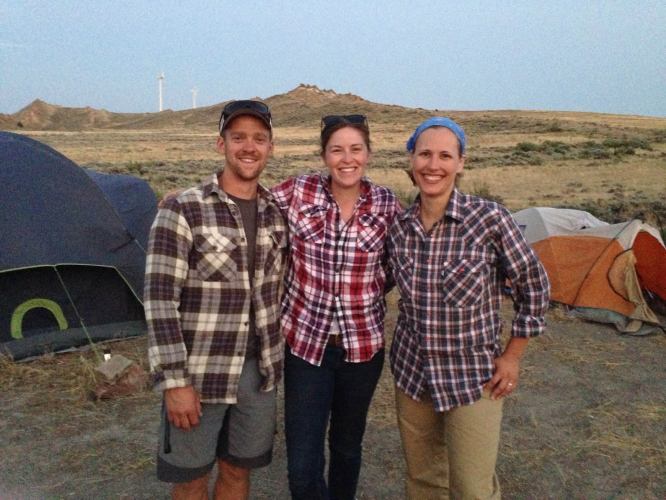Let’s Get Started
By Lexi on September 10, 2014
How The Bearded Lady Project Came to Be
I’ve learned that you shouldn’t go through life with a catcher’s mitt on both hands; you need to be able to throw something back. –Maya Angelou
There’s power in looking silly and not caring that you do. –Amy Poehler
I hadn’t showered in three days. It was the middle of the day in the Hanna Basin and the sun beat down on my pasty skin with a throbbing heat I had never felt before, but the lack of shade was the least of my worries. As I crouched down, I listened carefully for the rattle of an angry rattlesnake while simultaneously double-checking that the rocks, the same ones I would soon be resting my knees upon, weren’t hiding scorpions. “It’s the little ones that will kill you” they had informed me. I took a moment to pause, wiping the excessive amount of sunscreen away from my eyes with my still raw and stinging hand (thanks to the most recent steep ledge I’d attempted to traverse). I would have made it too, had it not been for the extra 30 pounds of camera equipment I had strapped to my body. Finally, I lifted the hot, black camera up to my face and focused the lens on Dr. Ellen Currano, a paleobotanist who sat on the ground, diligently hacking at rocks. You might not believe it, but at that moment, working diligently under the afternoon sun, Ellen and I were two women, living their dreams at the very same time and in the very same location: Ellen, doing her field research and me, Lexi Jamieson Marsh, shooting a documentary film in the Hanna Basin, Wyoming. It might be hard to imagine living and working in these rough conditions, and enjoying the lack of internet, cellphone coverage, and general hygiene. The truth is, when you find something you’re passionate about, the details of the everyday don’t matter. Ellen and I were not only working in our dream jobs, we were having the time of our lives; we’re ready and waiting to do it all over again!

In late April 2014, I sat down to dinner with my friend and personal hero, Dr. Ellen Currano. I hand’t seen Ellen in a very long time, maybe a few months at this point. The time apart was tragic, especially considering we both lived in the same town, no more than a seven-minute drive from one another. Such a small amount separation that could have easily been remedied over the course of the following month, had Ellen not just announced that she would be leaving our small Midwestern town for Laramie, Wyoming. I was silently heartbroken.
I had met Ellen five years earlier when both of us found ourselves living in a small college town in southwestern Ohio. Ellen was a woman I was immediately drawn to and someone who, I discovered early on, was living my childhood dream of adventuring into the wilderness to dig up fossils. She was by far the coolest person I had ever met. She was outdoors-y, she was bright, and above all, Ellen was passionate. It was Ellen’s passion and love for her work that made her someone I came to truly admire and respect. Fast forward to the Spring of 2014, and you can imagine how shocking and demoralizing it was to hear Ellen even suggest, let alone state how difficult it was to gain respect in her field for the simple fact that she was a woman; physically unable, legitimately impossible to fit the constructed “image” somehow expected of her by the watching world.
As Ellen spoke about her reality, I nodded, letting her words wash over me, words I knew too well because I too was not the ideal image of what my career path had constructed for me as a female film director. There were countless experiences we shared, experiences we didn’t need to be reminded of, experiences that left both of us feeling consistently less than valued members of a so called equal society. Regardless of how hard or how long we worked, nothing seemed to be changing within the professions we dedicated our lives to. It was a hopeless feeling, losing my friend to a new job across the country, all the while being reminded of the fact that all of our collected efforts would probably go unrecognized. I felt lost and alone. That’s when Ellen said, “I’ve decided to do something.”
Ellen had made the decision to take a pro-active approach to correcting the serious lack of female faces seen in the field of paleontology. Ellen set a personal challenge for herself, she was going to be the one to seek out the other women working in her field, and showcase them and their research on her blog she called “An Unsuitable Job for a Woman.” The idea was brilliant! If the world and all who control it were not willing to highlight the work of these women, then Ellen was going to put the time and the effort into proving, not only that these women exist, but also that they are actively contributing to their field. As the night went on, Ellen and I found the lighter side to our predicament, now laughing because all the reasons women were not considered equals felt, well …. Silly! “It seems like the only way to gain respect as a field scientist would be to put on a beard!” I laughed, clutching my stomach while Ellen nodded and chuckled. “Sounds about right.” She confided. “And wouldn’t it be funny if you wore a beard in the field, just to prove a point!” I continued, laughing even harder at the thought of Ellen donning a beard. “Maybe we could take pictures of ourselves!” Ellen added, now roaring with laughter. It was hilarious, the idea of dressing up like the stereotype, the thing that was holding you back. But when I woke up at 2:00am the next morning, the idea didn’t seem so funny anymore; the idea of women wearing beards in the field seemed life changing! I grabbed my phone and quickly wrote Ellen an email, detailing my ideas for how we could turn this joke into a documentary film and maybe more.

Luckily, Ellen did not think I was crazy, and with her blessing, we moved forward with this project. In July 2014, I found myself on the edge of that cliff in the Hanna Basin, camera focused on Ellen, our project officially moving forward. As I hit record, I could sense the rest of our team moving into position; Ellen and I were no longer the only people who believed in this concept. Next to me stood two incredible photographers, Kelsey Vance and Draper White, both working pro bono, adding their creative expertise to the core of The Bearded Lady Project. What started out as an idea that would only require an iphone to snap some pictures of female paleontologists wearing beards in the field, now transformed into the making of a documentary film, recreating historical portraits of the female adventurers that just don’t exist in our textbooks, and building a scholarship fund to help the next generation of bad-ass female scientists. It is because of our collective work and the belief in this project that you are able to sample a taste of our vision on our website today.
I have been asked on more than a few occasions how we came up with the idea of putting fake beards on respected field scientists, and all in the name of equality. The truth is that this idea didn’t start because I was looking for another idea for a film, or because Ellen was looking for a forum to air her buried feelings. This concept is based on friendship, and on a shared experience of being a woman in the workforce. This project exists because we I truly believe that a film like The Bearded Lady Project needs to exist. If you’re still asking why, here are my reasons: This film needs to exist because we need to see women working hard, that success doesn’t happen easily or overnight. Because we need young girls will feel inspired, motivated, and supported in whatever career path they choose. We need to see everyday women succeeding as the smart, adventurous and beautiful people that they are. We need to see women playing and making fun of themselves. We need to see women wearing beards because the reality is, those are the images that we are bombarded with and no one asks why. Overall, we need to see that women exist.
I have many hopes for this project: I hope that people will take a closer look at what real women are capable of. I hope that this project will challenge the singular representation of what a field scientist should look like. I hope to bring laughter to those who see this film and that maybe, once the laughter has stopped, our audience will begin to notice the lack of positive female role models that grace the covers of science magazines and TV shows. Above all, my hope is that we recognize that this isn’t just about what’s seen on the outside, the beard or lack thereof, that we return to the most important part that defines each and every one of us, that we see what exists on the inside.
We are just on the cusp of the journey that is The Bearded Lady Project, but each step forward, brings all of those hopes closer to reality.